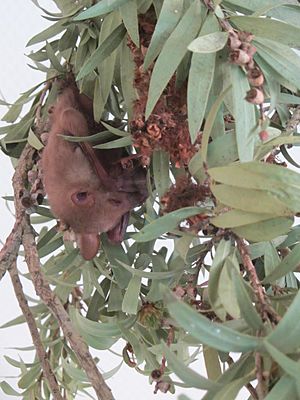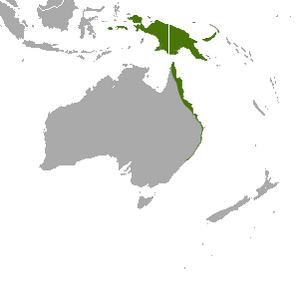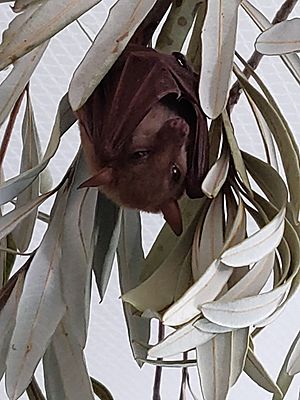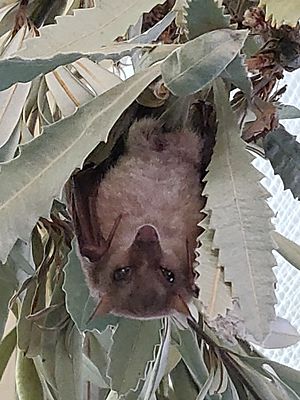Common blossom bat facts for kids
Quick facts for kids Common blossom bat |
|
|---|---|
 |
|
| Conservation status | |
| Scientific classification | |
| Genus: |
Syconycteris
|
| Species: |
australis
|
 |
|
| Common blossom bat range | |
The common blossom bat (Syconycteris australis) is a small, furry creature that flies at night, just like other bats! It's also called the southern blossom bat or Queensland blossom bat. These bats are part of a group called megabats, which are usually bigger than other bats. But guess what? The common blossom bat is one of the tiniest megabats that loves to drink nectar and eat pollen from flowers, instead of munching on fruit like some of its relatives. It's one of eight types of these flower-loving bats found in Australia.
Contents
What Does a Blossom Bat Look Like?
These bats are super small! They weigh only about 17.5–21 g (0.62–0.74 oz), which is like weighing just a few coins. Their body, not counting their legs, is around 60 mm (2.4 in) long. Imagine a bat that can fit in the palm of your hand!
How Do Blossom Bats Live?
Common blossom bats usually live alone or in very small groups. This makes it tricky for scientists to count how many there are just by looking! They often rest during the day in the lower parts of tropical rainforest trees.
Daily Life and Food
These bats might change where they sleep every day. But if there's plenty of food, they don't move very far. They are really important for plants because they help with pollination. They carry lots of pollen from flower to flower, much more than birds do, and they fly longer distances at night.
One special tree, the bumpy satinash, is a favorite food source for these bats in North Queensland. Almost all the pollen found on their fur comes from this tree when it's flowering!
Finding Food and Staying Safe
Blossom bats need a lot of energy because the nectar from one flower doesn't give them much. So, they have to visit many flowers every night – sometimes as many as 36 to 48 coast banksia flowers! This means they are busy flying and feeding for most of the night.
When the moon is full and bright, these bats wait longer before leaving their roosts. This is because they are careful about predators like owls, which hunt by sight. Other animals that might try to catch them include goannas (a type of lizard) and snakes that live in trees. Even pet cats can sometimes catch and hurt them.
Saving Energy
If there isn't much food around, or if it gets too cold (below 26 °C (79 °F)), these bats can go into a special state called torpor. This is like a mini-hibernation where they slow down their bodies to save energy. What's interesting is that they do this more often in the summer than in the winter, which is different from many other bat species!
Where Do Blossom Bats Live?
You can find common blossom bats in many places! They live in the Maluku Islands, Salawati, Biak, Yapen, New Guinea, the Aru Islands, the Bismarck Archipelago, Manus Island, the D'Entrecasteaux Islands, the Louisiade Archipelago, and in eastern New South Wales and Queensland in Australia. They can live anywhere from sea level up to 3,000 m (9,800 ft) high in the mountains. They especially like tropical rainforests and the special Littoral Rainforests of New South Wales found near the coast.
See also
 In Spanish: Syconycteris australis para niños
In Spanish: Syconycteris australis para niños




